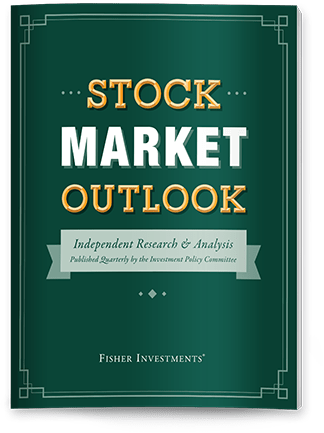Personal Wealth Management / Market Analysis
More Green Shoots in US Manufacturing
January’s business survey snapped a long-running slide.
Is the “stuff” economy finally turning a corner? For over two years, manufacturing—production of stuff—has slumped. Not just in the US, but globally. Stocks did fine—and GDP still grew—because the vast majority of activity happens in the mighty services sector. But there are signs of manufacturing green shoots, including this week’s purchasing managers’ indexes (PMIs) from the Institute for Supply Management (ISM). They show the US economy getting off to a fine start in January, with manufacturing finally returning to the party. Stocks have already proven they can do fine with manufacturing in the doldrums, but if this particular cylinder in the US’s economic engine is indeed firing again, it could alleviate a long-lingering fear.
PMIs are beloved among economic data watchers (like us). They are the first major series to come out for a given month, giving quick snapshots of whether activity is rising, falling or steady. As surveys, they aren’t perfect. They show the proportion of responding businesses reporting higher activity across a range of categories. A reading over 50 generally indicates expansion, and under 50 means contraction, but it isn’t an exact reflection of output, since businesses don’t report how much their activity rose or fell. So PMIs give you growth’s breadth, not its magnitude. But really, no data series is perfect, and PMIs have a long history as decent pencil sketches. That, plus their expediency, wins them acclaim. At least, from us.
So it is good news that ISM’s Manufacturing PMI rose to 50.9 in January, its first expansion since October 2022.[i] It wasn’t completely out of the blue, given the forward-looking New Orders component flipped above 50 in November. Today’s orders are tomorrow’s production, so it was a matter of time before that rebound translated to headline growth. And most encouragingly, New Orders have improved steadily, notching a handy 55.1 in January.[ii] Meanwhile, inventories continued declining. With the recent acceleration in consumer spending on goods showing healthy demand, the likelihood of restocking driving more orders and production seems to be rising.
The US economy doesn’t need manufacturing growth in order to keep expanding. Services has more than proven it can do the heavy lifting. But ISM’s Services PMI has also slowed a bit lately, including in January. The headline reading, 52.8, inched down from December’s 54.0.[iii] New orders slipped to 51.3 from December’s 54.4.[iv] Don’t get us wrong, these readings are all fine and dandy. Growth is growth, and PMI fluctuation is normal. But there is a modest downshift since mid-autumn, making this a fine time for physical goods to resume contributing to growth—if, indeed, that is happening.
When assessing economic data, there is always the possibility of getting fooled by one-off wiggles. Trends, frustratingly, are clear only in hindsight. But PMIs aren’t the only measure showing a manufacturing pickup—an encouraging sign. Core capital goods orders, which strip out defense and notoriously volatile aircraft, rose in five of the past seven months through December. Growth ended the year more consistent than it started. The manufacturing component of the monthly industrial production report also picked up late last year, growing 0.5% m/m in November and 0.6% in December.[v] This includes a big contribution from durable goods, a long-running sore spot. Imports, which includes components and resources used in American manufacturing, also ticked up late last year. Some note that last part is largely businesses anticipating tariffs. Perhaps. The manufacturing uptick even beyond this could be a false dawn. But it is a potential positive development worth watching.
Given private goods-producing industries are just 17.1% of US GDP, a manufacturing resurgence wouldn’t be a massive tailwind.[vi] But we can see it helping sentiment, adding to the budding optimism that helps drive returns as bull markets grow and mature. While private services are far more important to overall growth, at 71.7% of GDP, services isn’t what people think of when they think of the US economy.[vii] Sentiment is tied more to physical goods. You can touch them. Count them. See them roll off assembly lines. Most of our economic data focus on them. So improvement would touch a range of widely watched indicators, giving the perception of broad economic health.
It would also lift The Conference Board’s Leading Economic Index (LEI), which has wrongly signaled an incoming recession since early 2022. It rightly pointed to manufacturing’s downturn but falsely equated that with a pending broad economic decline. That had folks worried. If manufacturing improvement helped LEI turn the corner, it would probably be a tonic for investors.
So while the effects of a manufacturing recovery on US economic fundamentals probably aren’t huge, they don’t need to be. If manufacturing’s troubles weren’t bearish, then its return to good times probably won’t be massively bullish. Heck, if it turns out to be a global resurgence, it would probably be better for European stocks, given their long-running economic concerns and heavier tilt to value stocks like Industrials. But manufacturing has been a brick in US stocks’ wall of worry, and easing fears are bullish.
If you would like to contact the editors responsible for this article, please message MarketMinder directly.
*The content contained in this article represents only the opinions and viewpoints of the Fisher Investments editorial staff.
Get a weekly roundup of our market insights
Sign up for our weekly e-mail newsletter.

You Imagine Your Future. We Help You Get There.
Are you ready to start your journey to a better financial future?

Where Might the Market Go Next?
Confidently tackle the market’s ups and downs with independent research and analysis that tells you where we think stocks are headed—and why.





